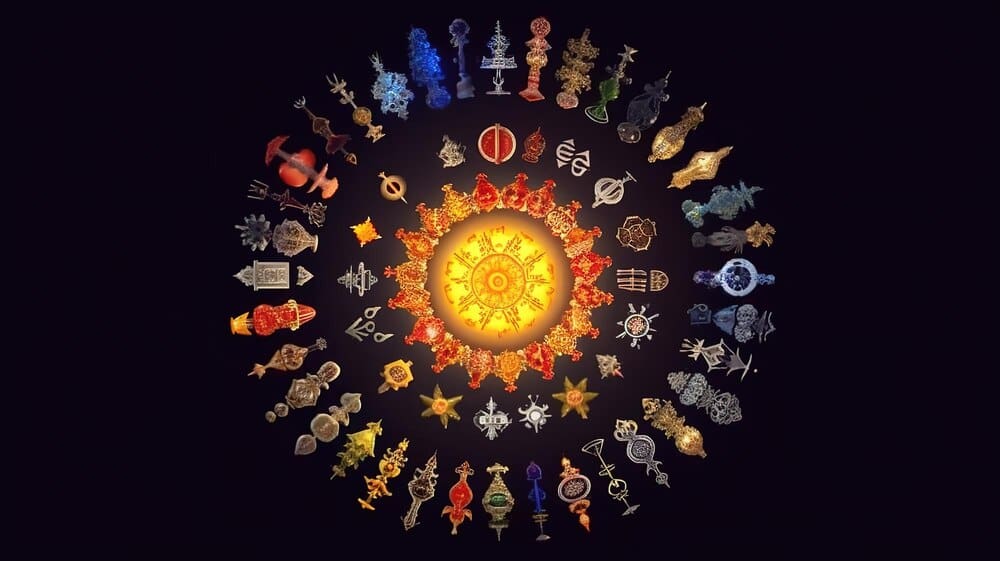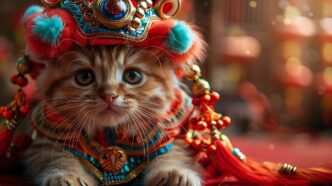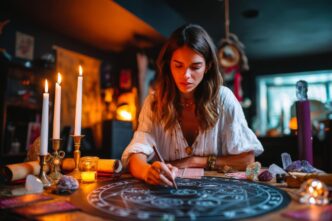In the intricate cosmic map of Vedic astrology, the 27 Nakshatras, or lunar mansions, offer a profoundly personal layer of insight that transcends the broader strokes of the 12 zodiac signs. Each of these celestial segments is governed by a specific presiding deity (devata) and represented by a unique symbol, which together reveal the core energetic blueprint, karmic purpose, and spiritual lessons embedded in an individual’s chart. Understanding who these divine archetypes are and what their symbols signify is crucial, as they provide the “why” behind our innate tendencies, guiding us toward self-realization and alignment with our highest path.
What Are Nakshatras?
While Western astrology primarily focuses on the Sun’s journey through the 12 zodiac signs, Vedic astrology, or Jyotish, places significant emphasis on the Moon’s path. The 360-degree celestial ecliptic is divided into 27 equal sections, each spanning 13 degrees and 20 minutes. These sections are the Nakshatras, and the Moon transits through one of them approximately every day.
This lunar focus makes the Nakshatra system incredibly personal and specific. The Nakshatra in which your Moon was placed at the moment of your birth is known as your Janma Nakshatra. It is considered the primary indicator of your consciousness, emotional landscape, and life’s karmic trajectory.
The Role of Deities and Symbols
The ancient seers, or Rishis, who channeled this knowledge, understood that cosmic energies were best comprehended through archetypes and tangible images. The deity and symbol assigned to each Nakshatra serve as powerful keys to unlocking its meaning.
Presiding Deities: The Guiding Force
The presiding deity of a Nakshatra is not an object of worship in a conventional sense, but rather the divine intelligence that embodies the star’s core qualities. The myths, attributes, and powers of the deity reveal the highest potential and the inherent challenges of the Nakshatra. Meditating on or learning about one’s Nakshatra deity can provide profound clarity on one’s life purpose, or dharma.
Symbols: The Visual Key
The symbol of a Nakshatra acts as a visual metaphor for its function and energy. These symbols are often drawn from nature, tools, or sacred objects, making the abstract cosmic energy relatable and understandable. The symbol provides clues about a person’s inherent skills, potential professions, and how they manifest their energy in the material world.
The 27 Nakshatras: A Journey Through the Cosmos
Each of the 27 Nakshatras possesses a unique combination of deity and symbol, creating a rich tapestry of meaning that unfolds across the zodiac. Below is a guide to the divine archetypes and visual keys for each lunar mansion.
1. Ashwini
Deity: The Ashwini Kumaras, the twin celestial physicians to the gods. They are known for their miraculous healing abilities, speed, and youthful vitality.
Symbol: A horse’s head. This symbolizes swiftness, power, new beginnings, and the ability to initiate action quickly.
2. Bharani
Deity: Yama, the god of death and dharma. He represents discipline, transformation, and the process of carrying souls from one reality to another.
Symbol: The yoni (the female organ of regeneration). This symbolizes the womb, creative potential, birth, death, and the gateway between worlds.
3. Krittika
Deity: Agni, the god of fire. Agni represents purification, digestion, transformation, and divine light.
Symbol: A razor, axe, or sharp blade. This symbolizes the power to cut through negativity, uncover truth, and perform decisive, purifying actions.
4. Rohini
Deity: Prajapati or Brahma, the Creator God. He embodies the force of creation, fertility, and growth.
Symbol: A cart or chariot. This represents commerce, fertility, the ability to carry goods or ideas, and steady progress.
5. Mrigashira
Deity: Soma (also Chandra), the Moon god. Soma represents the divine nectar of immortality (amrita), nourishment, and the mind’s fluctuations.
Symbol: A deer’s head. This symbolizes gentleness, sensitivity, curiosity, and a constant searching or seeking nature.
6. Ardra
Deity: Rudra, the fierce form of Shiva associated with storms. Rudra represents the power to destroy old structures to make way for new creation.
Symbol: A teardrop. This symbolizes cleansing, the release of sorrow, and the storms that bring renewal. It can also be seen as a diamond, representing brilliance forged under pressure.
7. Punarvasu
Deity: Aditi, the mother of the gods. She represents boundlessness, freedom, abundance, and the source of all things.
Symbol: A quiver of arrows. This symbolizes the ability to return, replenish resources, and hit a target from a distance. It signifies renewal and the return home.
8. Pushya
Deity: Brihaspati, the guru of the gods. He represents wisdom, spiritual knowledge, abundance, and divine grace.
Symbol: A cow’s udder or a flower. Both symbols represent nourishment, care, and the blossoming of potential. This is considered the most auspicious Nakshatra.
9. Ashlesha
Deity: The Nagas or Sarpas, divine serpent beings. They represent esoteric wisdom, primal energy (kundalini), and sudden insight.
Symbol: A coiled serpent. This symbolizes hidden knowledge, hypnotic power, intimacy, and the potential for both poison and divine wisdom.
10. Magha
Deity: The Pitris, the ancestral spirits. They represent tradition, lineage, legacy, and the blessings (or burdens) of our ancestors.
Symbol: A throne room or palanquin. This symbolizes royalty, authority, high status, and a connection to past achievements and power.
11. Purva Phalguni
Deity: Bhaga, the god of marital bliss, fortune, and prosperity. He represents enjoyment, love, and the fruits of good karma.
Symbol: The front legs of a bed or a hammock. This symbolizes rest, relaxation, pleasure, and enjoyment.
12. Uttara Phalguni
Deity: Aryaman, the god of patronage, contracts, and kindness. He represents integrity, helpfulness, and upholding social commitments.
Symbol: The back legs of a bed. This symbolizes commitment, partnership, and the support needed for long-term unions and endeavors.
13. Hasta
Deity: Savitur, a form of the Sun god. He represents inspiration, skill, and the power to manifest desires.
Symbol: The hand or a closed fist. This symbolizes skillfulness, craftsmanship, dexterity, and the ability to grasp and control outcomes.
14. Chitra
Deity: Tvashtar or Vishwakarma, the celestial architect. He represents craftsmanship, design, beauty, and the power to create magical forms.
Symbol: A bright jewel or a pearl. This symbolizes brilliance, beauty, artistry, and the ability to create something precious and well-crafted.
15. Swati
Deity: Vayu, the god of the wind. He represents movement, independence, communication, and life-breath (prana).
Symbol: A young shoot of grass swaying in the wind. This symbolizes flexibility, adaptability, and the ability to thrive independently.
16. Vishakha
Deity: Indra and Agni, the chief of the gods and the god of fire. Together they represent focused power, ambition, and determination.
Symbol: A triumphal archway or a potter’s wheel. This symbolizes achievement, celebration, purpose, and the patience to shape one’s goals.
17. Anuradha
Deity: Mitra, the god of friendship and partnership. He represents compassion, devotion, and the ability to form alliances.
Symbol: A lotus flower or a triumphal arch. The lotus symbolizes the ability to blossom in any environment, while the arch signifies success through collaboration.
18. Jyeshtha
Deity: Indra, the king of the gods. He represents power, authority, courage, and the challenges that come with leadership.
Symbol: A circular talisman, earring, or an umbrella. These symbolize protection, seniority, and established authority.
19. Mula
Deity: Nirriti, the goddess of destruction and dissolution. She represents the uprooting of old forms to get to the core truth.
Symbol: A tied bundle of roots. This symbolizes getting to the foundation of issues, investigation, and the constraints that must be broken.
20. Purva Ashadha
Deity: Apas, the goddess of the cosmic waters. She represents purification, emotional depth, and creative inspiration.
Symbol: A winnowing fan. This symbolizes the ability to separate the grain from the chaff, representing purification and the declaration of victory.
21. Uttara Ashadha
Deity: The Vishvadevas, the universal gods. They represent all divine qualities, including goodness, truth, and willpower.
Symbol: An elephant’s tusk or a plank from a bed. This symbolizes undefeatable victory, integrity, and the permanent results of one’s efforts.
22. Shravana
Deity: Vishnu, the preserver of the universe. He represents the all-pervading consciousness and the power of listening.
Symbol: An ear or three footprints. This symbolizes the art of listening, learning, tradition, and traversing different realms of knowledge.
23. Dhanishta
Deity: The eight Vasus, gods of earthly abundance. They represent wealth, rhythm, and material prosperity.
Symbol: A drum (damaru) or a flute. These symbolize rhythm, music, timing, and the ability to bring people together in harmony.
24. Shatabhisha
Deity: Varuna, the god of the cosmic oceans and universal law. He represents divine law (rita), healing, and the mysterious unknown.
Symbol: An empty circle or 100 flowers/healers. This symbolizes containment, the hidden potential within a boundary, and collective healing.
25. Purva Bhadrapada
Deity: Aja Ekapada, the “one-footed goat.” This is a fierce, ascetic form of Rudra, representing spiritual fire and penance.
Symbol: The front legs of a funeral cot or a man with two faces. This symbolizes transformation, looking to both the past and future, and intense, fiery energy.
26. Uttara Bhadrapada
Deity: Ahir Budhnya, the serpent of the deep. He represents kundalini energy, wisdom from the subconscious, and divine stability.
Symbol: The back legs of a funeral cot. This symbolizes the completion of a cycle, wisdom gained through experience, and peaceful transition.
27. Revati
Deity: Pushan, the divine shepherd. He represents nourishment, safe travel, and guidance for souls on their final journey.
Symbol: A fish or a drum. The fish symbolizes the vast cosmic waters of consciousness, while the drum represents marking time and keeping rhythm for travelers.
How to Use This Knowledge
Your primary Nakshatra placements—especially your Moon, Ascendant (Lagna), and Sun—hold the keys to your deepest nature. By studying the deity and symbol associated with your key Nakshatras, you can gain a profound understanding of your innate gifts and challenges. Meditating on these archetypes can help you align with your soul’s purpose and navigate life’s challenges with greater wisdom and grace.
In conclusion, the deities and symbols of the Nakshatras are far more than mythological curiosities. They are a sophisticated and deeply spiritual system for understanding the subtle energies that shape our lives. By engaging with this ancient wisdom, we can unlock a more nuanced and compassionate understanding of ourselves and our place in the cosmic dance, transforming our astrological chart from a static map into a dynamic guide for conscious living.








